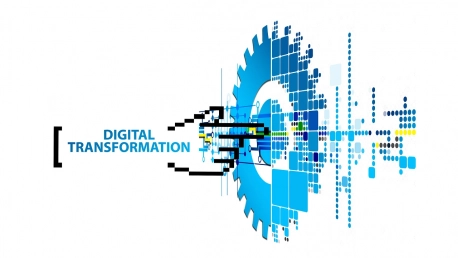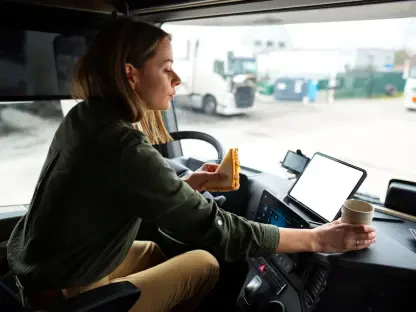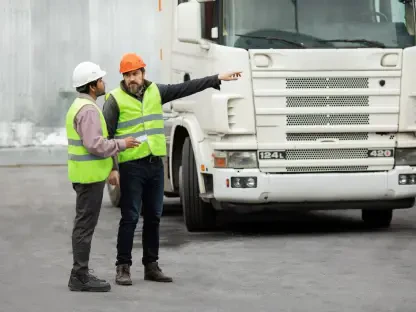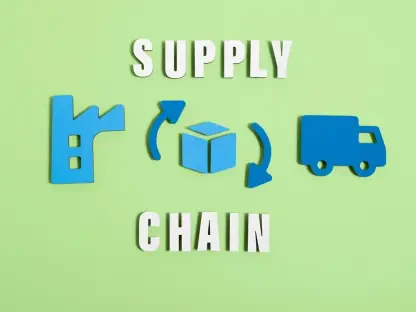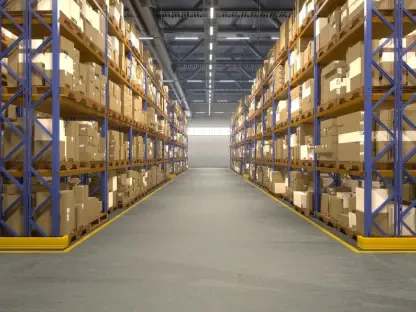The evolving landscape of e-commerce logistics is rapidly driven by digital transformation, forcing companies to adapt to new technologies. To meet the rising demands of e-commerce consumers who seek faster delivery, real-time notifications, and seamless transactions, the integration of advanced technologies in logistics operations becomes increasingly important. Logistics companies are compelled to move away from traditional methods in favor of digitally empowered ecosystems. An Accenture study underscores this shift, noting that 76% of logistics leaders believe that neglecting digital innovation will put business operations at risk by 2024.The integration of these emerging technologies is not just a competitive edge but an essential strategy for survival. Logistics companies are finding themselves in a race to embrace digital innovation to keep up with the expectations set by modern consumers and to meet operational demands efficiently. As we delve into the specific technological advancements transforming this sector, it becomes clear that the landscape of logistics is amid significant change, forming what is now described as Logistics 4.0.
Technological Advancements in Logistics
Generative AI: A New Era in Logistics Intelligence
Generative AI (GenAI) is progressively replacing traditional AI due to its adaptive capabilities and promise of greater efficiency. Unlike traditional AI, which relies on structured data and predefined scenarios, GenAI operates more fluidly, processing dynamic environments akin to a human assistant. This adaptability is invaluable in logistics, where variables like weather, traffic, and demand can fluctuate unpredictably. Approximately 40% of supply chain companies are currently investing in GenAI to enhance their operations.Applications of GenAI in the logistics sector include GenAI-powered bots that negotiate costs and purchase contracts with vendors, thereby streamlining tender processing. These bots can analyze vast amounts of data to identify optimal pricing and delivery terms. Additionally, GenAI automates the carrier onboarding process, ensuring quick and efficient integration of new carriers into the supply chain. Another critical application is in real-time delivery route planning, where GenAI can dynamically reroute deliveries based on current traffic and weather conditions, hence reducing delays and increasing overall efficiency. Consequently, these innovations are making logistics operations smarter and more responsive to real-time changes.
Internet of Things (IoT): Data-Driven Logistics
IoT remains central to the concept of Logistics 4.0, providing the backbone for enhanced fleet management, supply chain traceability, and inventory control through smart mechanisms. Traditional IoT applications such as RFID and GPS sensors continue to play pivotal roles in tracking objects and vehicles. These technologies have become foundational, establishing a new standard for efficiency and precision in logistics. Simultaneously, advancements in telematics and data-capturing devices are further extending IoT’s capabilities.Among the newer IoT applications, 2D barcodes are processed faster than their standard counterparts, enhancing the speed and accuracy of data capture. AI cameras convert video feeds into actionable data, allowing for real-time monitoring and intervention. Embedded chipsets that address cyber threats add an extra layer of security, ensuring that the massive amounts of data generated and transmitted remain protected. Investment in IoT ranks second only to AI within the logistics industry, underscoring its crucial role in the ongoing digital transformation. With experts from KPMG, PWC, and BCG confirming this prioritization, it is evident that IoT-driven data is vital for modern logistics, making operations both efficient and secure.
Robotics and Autonomous Technologies
Robotics: Streamlining Operations
In the quest for increased operational speed and reduced errors, the adoption of robotics technology within logistics has surged. Since Amazon’s acquisition of Kiva Robotics in 2012, the sector has witnessed substantial evolution and integration of sophisticated robotic systems. Modern logistics now employ automated guided vehicles, mobile robots, automated forklifts, and advanced retrieval and storage systems. These robots adeptly navigate human environments, optimizing space use and autonomously handling inventory, thus significantly enhancing efficiency within warehouses and distribution centers.The impact of robotics technology in logistics goes beyond simple automation. These systems are integral to continuous operations, handling repetitive tasks with high precision and minimal error rates. For example, automated guided vehicles can transport goods across vast warehouse spaces, while mobile robots manage stock replenishment and picking tasks. This reduces the workload on human employees and mitigates risks associated with manual labor. Implementing such technologies allows for quicker order processing and more accurate stock management, catering to the high demands of e-commerce businesses. Therefore, robotics has become foundational for logistics companies striving to improve efficiency and accuracy in their operations.
Unmanned Aerial Vehicles (UAVs): Revolutionizing Last-Mile Delivery
UAVs, commonly known as drones, are rapidly becoming a game-changer in the realm of last-mile delivery, the most critical phase in the logistics process. There is significant investment in expanding drone fleets for parcel and medical supplies delivery across 27 countries, including India. Leading companies such as Zipline, Wing, and Matternet are at the forefront of this innovation, pioneering the concept of instant logistics. These companies deploy drone fleets that ensure expedited, reliable deliveries, especially in areas that are challenging to access using traditional methods.In the UK and the US, firms like Starship Robotics have also achieved remarkable milestones, completing two million autonomous deliveries in 2021. These accomplishments highlight UAVs’ ability to significantly improve delivery times, reduce costs, and enhance service reliability. The use of drones presents a sustainable and efficient alternative to conventional delivery vehicles, particularly in urban settings plagued by traffic congestion. By overcoming logistical hurdles and expediting deliveries, UAVs enhance customer satisfaction, making them an indispensable component of modern logistics frameworks. Thus, UAVs represent a leap toward more efficient, cost-effective, and reliable last-mile delivery solutions.
Digital Twins and Augmented Reality (AR)
Digital Twins: Virtual Simulations for Real-World Efficiency
Digital Twins technology has emerged as a pivotal tool in creating real-life simulations of assets from their creation to end-of-life, offering comprehensive virtual models. This technology allows companies to simulate, predict, and optimize logistical operations before physical implementation, thereby reducing risks and inefficiencies. The integration of Digital Twins with other technologies such as AI, cloud computing, and IoT furthers its capabilities, providing detailed spatial models that facilitate better visualization and decision-making.The fusion of Digital Twins with predictive analytics enables companies to foresee potential issues and implement corrective measures proactively. This combination is particularly effective in predictive maintenance, where real-time monitoring of equipment can prevent breakdowns and minimize downtime. Additionally, Digital Twins support more informed decision-making by offering a holistic view of operations, thus improving overall responsiveness and efficiency. This level of insight allows logistics companies to optimize routes, manage resources effectively, and enhance service delivery, ultimately leading to more streamlined and resilient supply chain operations.
Augmented Reality (AR): Enhanced Workforce Productivity
Augmented Reality (AR) substantially boosts workforce productivity and enhances quality control techniques by providing better visualization and spatial understanding of logistical operations. When combined with Digital Twins, AR offers a comprehensive, real-time view of logistical workflows, facilitating improved training, maintenance, and operational planning. AR-enabled devices can guide workers through complex tasks step-by-step, reducing errors and minimizing the need for extensive training periods, thus significantly enhancing worker efficiency and accuracy.AR technology also plays a crucial role in streamlining warehouse operations. For instance, AR goggles can display real-time information such as inventory levels, product locations, and optimal picking paths, allowing employees to perform their tasks more efficiently. Moreover, AR can aid in remote assistance and troubleshooting, enabling experts to guide on-site workers through intricate procedures without needing to be physically present. By enhancing both training and real-time operations, AR technologies help logistics companies achieve greater efficiency and accuracy while providing a safer and more engaging working environment. This technological integration ensures that workforce productivity remains high, even as logistical complexities grow.
Future Outlook and Emerging Technologies
Innovating Beyond 2024
As the logistics sector looks toward the future, specifically to 2030, it is evident that continuous change is the only certainty. Emerging technologies such as quantum computing, enhanced risk management using Generative AI, the advent of 6G cellular networks, hydrogen fuel cells, and smart grid technology are expected to reshape the logistics landscape. Quantum computing, for instance, holds the potential to revolutionize complex logistical calculations by providing unprecedented computational power. This could lead to more optimized supply chain management, improving efficiency at all levels.The introduction of 6G networks promises to enable faster, more reliable communications, significantly benefiting real-time data transfer and connectivity. Hydrogen fuel cells and smart grid technology reflect the sector’s shift toward sustainable and energy-efficient solutions. These technologies provide not only greener alternatives but also more reliable and cost-effective energy sources for logistics operations. Collectively, these innovations suggest a future where logistics operations are faster, more efficient, and increasingly sustainable, driven by the relentless pace of technological advancement.
Sustainability: An Ever-Present Priority
The dynamic world of e-commerce logistics is being rapidly transformed by digital innovation, compelling companies to adapt swiftly to cutting-edge technologies. As e-commerce consumers increasingly demand faster deliveries, real-time updates, and smooth transaction processes, the integration of advanced technological solutions in logistics operations becomes crucial. Traditional logistics methods are being overshadowed by digitally empowered systems. An Accenture report highlights this trend, revealing that 76% of logistics leaders believe that ignoring digital innovation will jeopardize business operations by 2024.Embracing these emerging technologies is not merely an advantage but a crucial survival strategy. Logistics companies are in a race to adopt digital innovations to match contemporary consumer expectations and operational demands efficiently. Technologies like artificial intelligence, blockchain, and IoT are revolutionizing logistics, enhancing supply chain transparency, and streamlining processes. As we explore these advancements, it becomes evident that the logistics sector is undergoing significant changes, often referred to as Logistics 4.0, marking a new era in logistics management.
